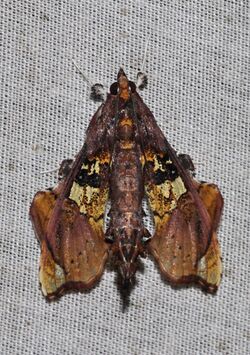Biology:Terastia
From HandWiki
Short description: Genus of moths
| Terastia | |
|---|---|

| |
| Terastia egialealis adult | |
| Scientific classification | |
| Domain: | Eukaryota |
| Kingdom: | Animalia |
| Phylum: | Arthropoda |
| Class: | Insecta |
| Order: | Lepidoptera |
| Family: | Crambidae |
| Tribe: | Margaroniini |
| Genus: | Terastia |
| Synonyms | |
| |
Terastia is a genus of snout moths in the subfamily Spilomelinae of the family Crambidae. It was described by Achille Guenée in 1854 with Terastia meticulosalis as type species.[1] The genus is currently placed in the tribe Margaroniini,[2] where it is closely related to the genera Agathodes and Liopasia.[3][4][2]
Terastia with its eight species is distributed in the tropical regions of the Neotropical, Afrotropical and Oriental realm as well as Australasia.
Like the closely related genera Agathodes and Liopasia, the caterpillars of Terastia species feed on Erythrina species (Fabaceae).[5][6][7][8]
Species
- Terastia africana Sourakov in Sourakov, Plotkin, Kawahara, Xiao, Hallwachs & Janzen, 2015[4]
- Terastia diversalis (Walker, 1866)
- Terastia egialealis (Walker, 1859)
- Terastia margaritis (C. Felder, R. Felder & Rogenhofer, 1875)
- Terastia meticulosalis Guenée, 1854
- Terastia minor Koningsberger & Zimmermann, 1901
- Terastia proceralis Lederer, 1863
- Terastia subjectalis Lederer, 1863
References
- ↑ Cite error: Invalid
<ref>tag; no text was provided for refs namedGlobIZ - ↑ 2.0 2.1 Mally, Richard; Hayden, James E.; Neinhuis, Christoph; Jordal, Bjarte H.; Nuss, Matthias (2019). "The phylogenetic systematics of Spilomelinae and Pyraustinae (Lepidoptera: Pyraloidea: Crambidae) inferred from DNA and morphology". Arthropod Systematics & Phylogeny 77 (1): 141–204. doi:10.26049/ASP77-1-2019-07. ISSN 1863-7221. https://www.senckenberg.de/de/07_asp_77-1_mally_141-204/.
- ↑ Munroe, Eugene G. (1960). "New tropical Pyraustinae (Lepidoptera: Pyralidae)". The Canadian Entomologist 92 (3): 164–173. doi:10.4039/Ent92164-3. https://www.cambridge.org/core/journals/canadian-entomologist/article/new-tropical-pyraustinae-lepidoptera-pyralidae/714FC2D803D1055DE45E94A84299C912.
- ↑ 4.0 4.1 Sourakov, Andrei; Plotkin, David; Kawahara, Akito Y.; Xiao, Lei; Hallwachs, Winnie; Janzen, Daniel (2015). "On the taxonomy of the erythrina moths Agathodes and Terastia (Crambidae: Spilomelinae): Two different patterns of haplotype divergence and a new species of Terastia". Tropical Lepidoptera Research 25 (2): 80–97. https://journals.flvc.org/troplep/article/view/93235/89352.
- ↑ Hinckley, Alden D. (1964). "Ecological notes on the larvae of some pyraloid moths in Fiji". Pacific Insects 6 (2): 234–241. http://hbs.bishopmuseum.org/pi/pdf/6(2)-234.pdf.
- ↑ Kimball, C.P. (1965). "The Lepidoptera of Florida: an annotated checklist". Arthropods of Florida and Neighbouring Land Areas 1: i-v, 1–363. http://palmm.digital.flvc.org/islandora/object/uf%3A43115#page/dpi/mode/1up.
- ↑ Sourakov, Andrei (2012). "On the biology of moths that feed on Erythrina in Florida". Tropical Lepidoptera Research 22 (2): 110–118. https://journals.flvc.org/troplep/article/view/90311/86666.
- ↑ Pereira, C.M.; Moura, M.O.; Da-Silva, P.R. (2014). "Insect seed predators in Erythrina falcata (Fabaceae): Identification of predatory species and ecological consequences of asynchronous flowering". Neotropical Entomology 43 (3): 193–200. doi:10.1007/s13744-014-0213-1. PMID 27193614. https://www.researchgate.net/publication/262572862.
External links
- Terastia at Markku Savela's Lepidoptera and Some Other Life Forms
Wikidata ☰ Q7701604 entry
 |

